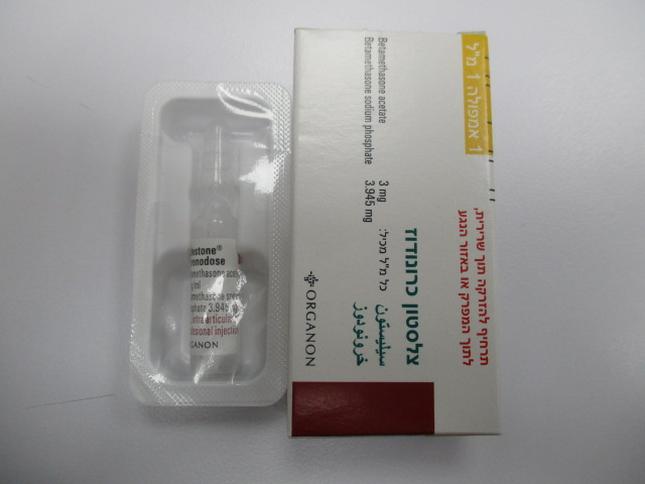Quest for the right Drug

צלסטון כרונודוז CELESTONE CHRONODOSE (BETAMETHASONE ACETATE, BETAMETHASONE SODIUM PHOSPHATE)
תרופה במרשם
תרופה בסל
נרקוטיקה
ציטוטוקסיקה
צורת מתן:
תוך-שרירי, תוך מפרקי, לתוך פצע : I.M, INTRA-ARTICULAR, INTRA-LESIONAL
צורת מינון:
תרחיף להזרקה : SUSPENSION FOR INJECTION
עלון לרופא
מינוניםPosology התוויות
Indications תופעות לוואי
Adverse reactions התוויות נגד
Contraindications אינטראקציות
Interactions מינון יתר
Overdose הריון/הנקה
Pregnancy & Lactation אוכלוסיות מיוחדות
Special populations תכונות פרמקולוגיות
Pharmacological properties מידע רוקחי
Pharmaceutical particulars אזהרת שימוש
Special Warning עלון לרופא
Physicians Leaflet
Indications : התוויות
4.1 Therapeutic indications The product is indicated in the management of conditions known to be responsive to corticosteroid therapy. When oral therapy is not feasible and the strength, dosage form, and route of administration of the drug reasonably lend the preparation to the treatment of the condition, Celestone Chronodose suspension for intramuscular use is indicated as follows: Endocrine disorders: Primary or secondary adrenocortical insufficiency (hydrocortisone or cortisone is the drug of choice; synthetic analogs may be used in conjunction with mineralocorticoids where applicable; in infancy, mineralocorticoid supplementation is of particular importance). Acute adrenocortical insufficiency (hydrocortisone or cortisone is the drug of choice; mineralocorticoid supplementation may be necessary, particularly when synthetic analogs are used). Preoperatively and in the event of serious trauma or illness, in patients with known adrenal insufficiency or when adrenocortical reserve is doubtful. Shock unresponsive to conventional therapy if adrenocortical insufficiency exists or is suspected. Congenital adrenal hyperplasia. Nonsuppurative thyroiditis. Hypercalcemia associated with cancer. Rheumatic disorders: As adjunctive therapy for short term administration (to tide the patient over an acute episode or exacerbation) in post-traumatic osteoarthritis; synovitis of osteoarthritis; rheumatoid arthritis, including juvenile rheumatoid arthritis (selected cases may require low-dose maintenance therapy); acute and subacute bursitis; epicondylitis; acute nonspecific tenosynovitis; acute gouty arthritis; psoriatic arthritis; ankylosing spondylitis. Collagen disease: During an exacerbation or as maintenance therapy in selected cases of: systemic lupus erythematosus; acute rheumatic carditis. Dermatologic diseases: Pemphigus: severe erythema multiforme (Stevens-Johnson syndrome); exfoliative dermatitis; bullous dermatitis herpetiformis; severe seborrheic dermatitis; severe psoriasis; mycosis fungoides. Allergic states: Control of severe or incapacitating allergic conditions intractable to adequate trials of conventional treatment in: bronchial asthma; contact dermatitis; atopic dermatitis; serum sickness; seasonal or perennial allergic rhinitis; drug hypersensitivity reactions; urticarial transfusion reactions; acute noninfectious laryngeal edema (epinephrine is the drug of first choice). Ophthalmic diseases: Severe acute and chronic allergic and inflammatory processes involving the eye, such as: herpes zoster ophthalmicus; iritis; iridocyclitis; chorioretinitis; diffuse posterior uveitis and choroiditis; optic neuritis; sympathetic ophthalmia; anterior segment inflammation; allergic conjunctivitis; allergic corneal marginal ulcer; keratitis. Gastrointestinal diseases: To tide the patient over a critical period of disease in: ulcerative colitis – (systemic therapy); regional enteritis – (systemic therapy). Respiratory diseases: Symptomatic sarcoidosis; berylliosis; fulminating or disseminated pulmonary tuberculosis, when used concurrently with appropriate antituberculous chemotherapy; Loeffler’s syndrome not manageable by other means; aspiration pneumonitis. Hematologic disorders: Acquired (autoimmune) hemolytic anemia. Secondary thrombocytopenia in adults. Erythro-blastopenia (RBC anemia). Congenital (erythroid) hypoplastic anemia. Neoplastic diseases: For palliative management of: leukemias and lymphomas in adults; acute leukemia of childhood. Edematous state: To induce diuresis or remission of proteinuria in the nephritic syndrome, without uremia of the idiopathic type or that due to lupus erythematosus. Miscellaneous: Tuberculous meningitis with subarachnoid block or impending block when used concurrently with appropriate antituberculous chemotherapy. Trichinosis with neurologic myocardial involvement. When the strength and dosage form of the drug lend the preparation to the treatment of the condition, the intra-articular or soft tissue administration of Celestone Chronodose suspension is indicated as adjunctive therapy for short-term administration (to tide the patient over an acute episode or exacerbation) in: synovitis of osteoarthritis; rheumatoid arthritis; acute and subacute bursitis; acute gouty arthritis; epicondylitis; acute nonspecific tenosynovitis; post-traumatic osteoarthritis. When the strength and dosage form of the drug lend the preparation to the treatment of the condition, the intra-lesional administration of Celestone Chronodose suspension is indicated for: keloids, localized hypertrophic, inflammatory lesions of lichen planus, psoriatic plaques, granuloma annulare, and lichen simplex chronicus (neurodermatitis); discoid lupus erythematosus; necrobiosis lipoidica diabeticorum; alopecia areata. Celestone Chronodose suspension may also be useful in cystic tumors of an aponeurosis or tendon (ganglia).

שימוש לפי פנקס קופ''ח כללית 1994
Rheumatoid arthritis, osteoarthritis, other arthritic conditions by intra-articular injection, inflammatory, allergic & rheumatic conditions requiring a glucocorticoid effect, in patients for whom treatment with oral corticosteroid is not feasible. יירשם ע"י רופא אורטופד
תאריך הכללה מקורי בסל
01/01/1995
הגבלות
תרופה מוגבלת לרישום ע'י רופא מומחה או הגבלה אחרת
מידע נוסף
